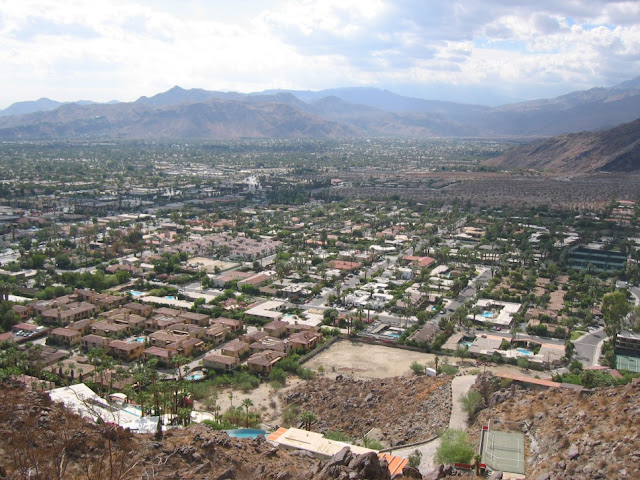By Angie Hong
(Reprinted from East Metro Water, April 26, 2017)
(Reprinted from East Metro Water, April 26, 2017)
 |
| Traditional lawn interspersed with bee-friendly Dutch white clover. |
When my dad moved to Palm Springs in 1987, the residential landscape there was eerily Midwestern. There were rows of tidy lawns in front of every house, petunias in the gardens, and pots of pansies on front porches. If it weren’t for the palm trees, one could have almost pretended they were in a town in Wisconsin or Ohio.
 |
| Palm Springs' green lawns and trees stand out against the earthen colored mountains. |
 |
| It's hard to believe that people are growing lawns in a landscape that looks like this. |
Of course, neither lawns nor petunias are well suited for the desert, and people in the Palm Springs area eventually realized that their landscape aesthetics would have to change. Over the years, when I headed south to visit my dad, I noticed that petunias had given way to desert blooms and many people had replaced their lawns with rock gardens. Landscaping in common areas began to change as well. Cities and homeowners’ associations transitioned to drought and heat tolerant xeriscaping and installed high-tech irrigation systems to reduce water usage.
Thirty years later, some people in the Midwest are starting to wonder if traditional lawns make sense anywhere, even here in our temperate climate. According to various estimates, there are about 40 million acres of lawn in the United States, 32 million of which are irrigated. In fact, there are more irrigated acres of lawn than corn! The U.S. EPA estimates that Americans use 9 billion gallons of water per day irrigating lawns. In addition, lawns use 3 million tons of fertilizer per year, 30,000 tons of pesticides, and 800 million gallons of gasoline.
 |
| Municipal water use during the summer spikes dramatically due to lawn watering. |
As we begin to rethink the “traditional” lawn, some people are advocating for a return to simpler ways when lawns were lower maintenance. Locally, the Pollinator Friendly Alliance has worked with the University of Minnesota to create a bee-friendly lawn mix that is low-growing and provides nectar for honeybees and native bees. To over-seed an existing lawn, scalp the grass to within 1 inch, rough up the soil with a rake, and then seed with a mix of 4lbs fine fescue, 7 Tbs white Dutch clover, 2 Tbs creeping thyme, and 7.5 Tbs self heal per 1000 square feet of lawn. Water for the first two weeks until the seeds germinate. After that, a bee-friendly lawn will not need water or fertilizer and only occasional mowing to keep it at a height of 3-4 inches.
 |
| A bee lawn includes a mix of low-growing fine fescue grasses, self heal, creeping thyme and Dutch clover.
Photo from Pollinator Friendly Alliance
|
Low-mow is another option that works for sunny or partially shady lawns. Comprised of fescue grasses that only need to be mowed once or twice a year when they go to seed, low-mow lawns don’t need to be watered or fertilized and will naturally block most weeds. Prairie Nursery in Wisconsin (www.prairienursery.com) is the most popular place to purchase low-mow seed mixes, although low-mow is also sold locally at Gertens and Minnesota Native Landscapes. To establish a low mow lawn, kill off your existing grass in late August and then seed in the low-mow mix around Labor Day.
 |
| Low mow grass only needs to be cut once or twice a year.
Photo by Douglas Owens-Pike
|
Even if you’re not ready to make a transition to a bee-friendly or low-mow lawn, there are a few simple changes you can make to save yourself time and protect water resources. First, resist the urge to apply avoid fertilizer in the spring. Fertilizer makes the grass grow faster (forcing you to mow more often) and tends to promote blade growth instead of root growth, making the grass less tolerant to drought during the summer. Set your mower blade higher (3-4in. tall) to encourage deeper roots, and mow less frequently or not at all during dry spells in the summer.
If you want to apply fertilizer, Minnesota Extension recommends one application around Labor Day. Get your soil tested first to ensure that you don’t waste money or give your lawn the wrong nutrients (http://soiltest.cfans.umn.edu). Most Minnesota lawns can survive without irrigation, but if you have an automatic system, install a rain sensor or soil moisture sensor and program your irrigation system to deliver no more than one inch (1in.) of water per week. On weeks that it rains, the lawn might not need to be watered at all. For more tips, download What to ask for from your lawn care provider or the Blue Thumb Year Round Guide to Yard Care at www.mnwcd.org/lawn-care.
Interested in learning more about lawn alternatives and water-friendly gardening? Stay tuned for a tour to be announced this summer.
Angie Hong
is an educator for East Metro Water Resources Education Program - www.mnwcd.org/emwrep - which includes Brown’s Creek, Carnelian Marine - St. Croix, Comfort
Lake – Forest Lake, Middle St. Croix, Ramsey Washington-Metro, Rice Creek,
South Washington and Valley Branch Watersheds, Cottage Grove, Dellwood, Forest
Lake, Grant, Hugo, Lake Elmo, Newport, Oak Park Heights, Oakdale, Stillwater,
St. Paul Park, West Lakeland, Willernie and Woodbury, Washington County and the
Washington Conservation District. Contact her at 651-330-8220 x.35 or angie.hong@mnwcd.org

No comments:
Post a Comment